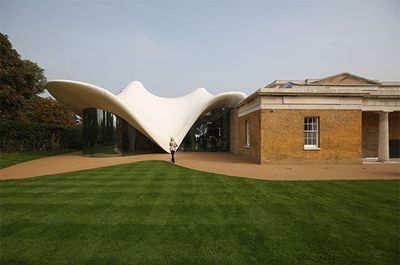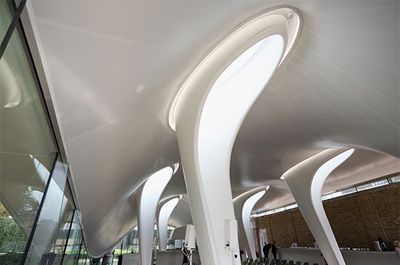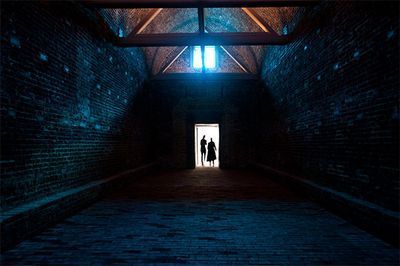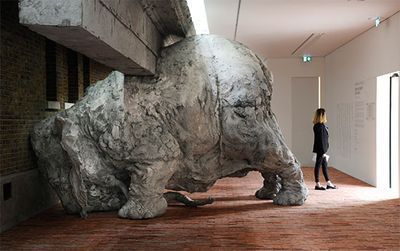Spoons in the Serpentine
By MIKA ROSS-SOUTHALL
A white-winged structure swoops
beside a nineteenth-century former gunpowder store in Kensington Gardens. It’s
the new Serpentine Sackler Gallery, which opens tomorrow (a five-minute walk
from the original Serpentine Gallery), and the distinctive design of the architect
Zaha Hadid. She has converted the grade II listed, neoclassical brick building
(“The Magazine”) into a gallery and created a membrane-roofed modern extension to
be used as a restaurant and social space.
“You don’t look forward by
looking backwards”, Hadid says, “you create structures that are adjacent and
juxtapose with historical buildings.” (Last night, the RIBA Stirling Prize 2013 was awarded to Witherford Watson Mann Architects for Astley Castle, a modern home inserted into the walls of an ancient castle.) The extension is certainly a twenty-first-century design. But the dynamic exterior is let down by the inside which feels like an airless white tent. The ceiling stretches high in the
centre; five columns, like upside-down Chinese soup spoons, support the billowing
domed roof and double as sky-lights. These are inspiring shapes, but the edges
of the structure claustrophobically envelop you. Where the roof curves to the ground
at three points, an overhang casts shadow on the cantilevered side-windows (and one
of the larger windows is mostly obstructed by the restaurant’s open kitchen). A
remarkable feature of the Serpentine Gallery is its positioning in the Royal
Park, yet the surrounding landscape is barely visible from inside.
The converted gallery space
is sensitively designed. A light, white cube encircles the two ready-made
vaulted rooms where gunpowder and munitions were kept during the Napoleonic wars.
Raw brickwork and beamed ceilings are exposed here, along with two very small
windows on either end of each chamber. So these rooms are dark, and perhaps
less versatile as display spaces, though they will probably stimulate more site-specific
work from artists.
Adrián Villar
Rojas, an Argentinean artist who is the first to exhibit in the new gallery, has
filled one of these vaulted “powder” rooms with an archive-like collection of
clay sculptures, found objects and living plants (including sprouting phallic
potatoes that nod towards Victor Grippo and the sculptural art tradition). All
are carefully positioned on towering glass shelves lit with brash strip
lighting, as if showcasing a fossilized history of humanity, perhaps from the
past, or perhaps a preserved future age. In the other “powder” room,
Rojas has put stained glass in the two windows, leaving the expansive space empty
and sacred. And throughout the gallery, the floor is covered with loose red
bricks (the whole space smells of damp earth) that beautifully clink underfoot,
and slow your pace, encouraging reflection.
In the white outer-ring
gallery, a huge clay elephant (below) carries a mock-up of the external façade
of the Sackler – is the elephant holding the old building up or is the animal
ramming it down? The same question can be asked of Hadid’s design interventions on the old building.
At the original Serpentine
Gallery sculptures made from raw materials by the Italian artist Marisa Merz also reflect the
fragility of the human condition. One installation, undated and untitled, features
nine clay pin-heads with searching faces on a square paraffin tray. Without any
indication of scale, they could be planets in the universe or stars in the sky.
A feeling of insignificance and anonymity, yet some of the heads flash with gold leaf.
The directors and curators
have thought carefully about the dialogue between Merz and Rojas’s exhibitions.
And an umbilical cord (the “Bridge Commission”) will always link the two
galleries. This year the focus is on literature – every month a new short story,
lasting the five minutes it takes to walk from one gallery to the other, will
be available as an audio download on visitors’ mobile phones. Twelve authors have been commissioned, including Ben Lerner, Adam
Thirlwell, Chimamanda Ngozi Adichie, Luisa Geisler and John
Jeremiah Sullivan; the
first story is by Valeria Luiselli.
The Serpentine is a mushrooming campus
of culture and experimentation. Earlier in the summer I wrote
about Sou Fujimoto’s breath-taking Serpentine pavilion. It was a joy
to walk past it again this week. I don’t think I’ll be saying the
same about Hadid’s extension.
Peter Stothard's Blog
- Peter Stothard's profile
- 30 followers







